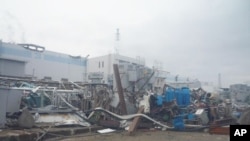The operators of Japan's Fukushima nuclear plant say they are moving equipment to higher ground after a series of strong aftershocks that have hampered efforts to repair the crippled facility.
Search crews meanwhile have moved within 10 kilometers of the stricken plant for the first time in their search for the bodies of victims of the March 11 earthquake and tsunami that knocked out cooling systems at the facility. Emperor Akihito and Empress Michiko visited Thursday with survivors in the worst-hit areas for the first time.
The latest strong aftershock came at about 6 a.m. local time Thursday, with a magnitude of 6.1. It was the fourth temblor since Monday with a magnitude of 6 or greater and the 14th with a magnitude greater than 5. Hundreds of aftershocks have rattled Japan's northeastern coast since last month's massive 9.0 earthquake.
Officials with the Tokyo Electric Power Company said they are reinforcing connections to the national electrical grid to make sure they have power to pump water into the plant's reactors and cooling ponds. A spokesman said generators and other equipment are being moved to higher ground to protect against another tsunami.
Outside the plant, about 300 policemen in protective white suits began picking through rubble inside of a 10-kilometer radius around the Fukushima plant for the first time. Search efforts in the area have been put off because of high radiation levels, but authorities want to recover bodies before they deteriorate to the point where they become a health hazard and impossible to identify.
In northern Japan, Emperor Akihito and Empress Michiko comforted survivors at two emergency shelters in the city of Asahi in Chiba Prefecture. The royal couple plans a series of visits to the hardest-hit areas in Iwate, Miyagi and Fukushima prefectures between now and May.
At the Fukushima plant, workers at the plant are also seeking a way to remove spent fuel rods from a storage pond at the plant's number four reactor, where elevated radiation levels have been detected in the water. Officials said Wednesday that the radiation levels suggest that some of the rods have been damaged, though most are likely intact.
Technicians managed to pump more than 250 tons of highly radioactive water out of a tunnel next to another of the plant's reactors on Wednesday, an essential step before they can resume work on repairing the unit's vital cooling systems. But Japan's NHK Television said the water level in the tunnel had risen again Thursday morning, suggesting water is still leaking into the tunnel from the reactor.
NHK quoted plant officials as saying radiation levels in the ocean near the plant have dropped dramatically since a leak was plugged last week but are still high. The latest reading found radioactive iodine at 2,500 the legal limit, compared to 7.5 million times the limit on April 2.
The network also reported that recent health ministry testing has found radiation at 25 times the legal limit in fish caught south of the nuclear plant on Wednesday, and that radioactivity was detected on 11 kinds of vegetables sampled in Fukushima prefecture on Monday.
The toll from the March 11 disaster continues to rise, with Japan's national police agency reporting more than 13,300 confirmed dead and more than 15,000 missing.
Japan's Kyodo news agency says many of the victims died when officially designated evacuation sites were swamped or washed away by the tsunami, which was as high as a three-story building when it hit the coast. The agency says it has identified more than 100 evacuation sites that failed to stand up to the tidal wave.
Some information for this report was provided by AP.










